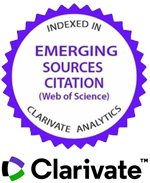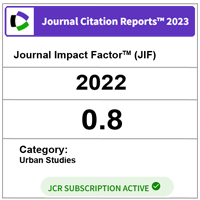Pandemic Responsive Spaces for Local Economic Activities in the Old Town of Semarang
DOI:
https://doi.org/10.11113/ijbes.v9.n2-2.1020Keywords:
COVID-19, pandemic, responsive space, economic activity, heritage sites, old townAbstract
The COVID-19 pandemic has changed all aspects of life and order. It has made the Old Town of Semarang experience a decrease in the number of visitors. When the economy is starting and recovering, the pandemic sensitivity space is exercised through strict health protocol. This paper uses direct observation to examine the pandemic responsive space for local economic activities in the Old Town of Semarang. The following procedures were adopted for this study: 1) Defining the potential economic activity space in the Old Town of Semarang; 2) Recognising the presence of pandemic responsive space in location; 3) Analysing the responsive space in relation to pandemic context, and 4) Proposing space pattern that responsive to pandemic context. The study’s results are the Old Town of Semarang has three typologies of economic activity spaces, including cafes, restaurants, and street vendors. The economic activity in the form of cafes and restaurants has organised a responsive space to implement the established health protocols. In contrast, street vendors create unresponsive space for economic activity. This is because the street vendors have not been able to provide adequate supporting facilities for health protocols. Therefore, the local government and economic actors need to speed up the process for determining more pandemic responsive urban space that will allow economic activities to be carried out with proper health protocols
References
Andersen, M. (2020). Early evidence on social distancing in response to COVID-19 in the United States. Available at SSRN 3569368. [crossref]
Bahadursingh, N. (2020). 8 Ways COVID-19 Will Change Architecture. https://architizer.com/blog/inspiration/industry/covid19-city-design/. Retrieved on 20 August 2021.
Goniewicz, K., Khorram-Manesh, A., Hertelendy, A. J., Goniewicz, M., Naylor, K., & Burkle, F. M. (2020). Current response and management decisions of the European Union to the COVID-19 outbreak: a review. Sustainability, 12(9): 3838.
Gössling, S., Scott, D., Hall, C. M., Gössling, S., Scott, D., & Pandemics, C. M. H. (2021). Pandemics , tourism and global change : a rapid assessment of COVID-19. Journal of Sustainable Tourism, 29(1): 1–20. https://doi.org/10.1080/09669582.2020.1758708
Guenther, R., & Vittori, G. (2014). Sustainable Healthcare Architecture.
Hercules, F., Anderson, D., & Sansom, M. (2020). Architecture Is a Critical Ingredient of Pandemic Medicine. https://www.architectmagazine.com/practice/architecture-is-a-critical-ingredient-of-pandemic-medicine_o. Retrieved on 20 August 2021.
Honey-Rosés, J., Anguelovski, I., Chireh, V. K., Daher, C., van den Bosch, C., Litt, J. S., Mawani, V., McCall, M. K., Orellana, A., Oscilowicz, E., & others. (2020). The impact of COVID-19 on public space: an early review of the emerging questions--design, perceptions and inequities. Cities & Health, 1–17.
Jain, D., & others. (2020). Effect of COVID-19 on restaurant industry--how to cope with changing demand. Effect of COVID-19 on Restaurant Industry--How to Cope With Changing Demand (April 16, 2020).
Kemenparekraf. (2020). Statistik Kunjungan Wisatawan Mancanegara 2020. Pusat Data Dan Sistem Informasi. https://www.kemenparekraf.go.id/statistik-wisatawan mancanegara/Statistik-Kunjungan-Wisatawan-Mancanegara-2020. Retrieved on 30 March 2021.
Khorram-Manesh, A., Carlström, E., Hertelendy, A. J., Goniewicz, K., Casady, C. B., & Burkle, F. M. (2020). Does the prosperity of a country play a role in COVID-19 outcomes? Disaster Medicine and Public Health Preparedness, 1–10.
Kono, T., Adetunji, O., Jurčys, P., Niar, S., Okahashi, J., & Rush, V. (2020). The Impact of COVID-19 on heritage: an Overview of Responses by ICOMOS National Committees (2020) and Paths Forward.
Kurniawati, W., Kurniati, R., Soetomo, S., Rahmat, R. R. B., & Firdaus, A. S. (2020). Mapping the Potential Economy in The Old Town of Semarang to Support Its Sustainability. Jurnal Teknik Sipil Dan Perencanaan, 22(2): 110–116.
Lau, H., Khosrawipour, V., Kocbach, P., Mikolajczyk, A., Ichii, H., Schubert, J., Bania, J., & Khosrawipour, T. (2020). Internationally lost COVID-19 cases. Journal of Microbiology, Immunology and Infection, 53(3): 454–458.
Mass Design Group. (2020). Spatial Strategies for Restaurants in Response to COVID-19. https://massdesigngroup.org/COVIDRESPONSE. Retrieved on 30 March 2021.
Maturana, B., Salama, A. M., & McInneny, A. (2021). Architecture, urbanism and health in a post-pandemic virtual world. Archnet-IJAR: International Journal of Architectural Research. 15(1): 1-9.
Moosa, I. A. (2020). The effectiveness of social distancing in containing. Applied Economics, 52(58): 6292–6305. https://doi.org/10.1080/00036846.2020.1789061
National Restaurant Association. (2020). COVID-19 Operating Guidance: A Guide for The Restaurant Industry. https://restaurant.org/articles/news/download-latest-covid-19-safe-operating-guidance Retrieved on 30 March 2021.
Newsome, D. (2020). The collapse of tourism and its impact on wildlife tourism destinations. https://doi.org/10.1108/JTF-04-2020-0053 Retrieved on 1 April 2021.
Pepe, E., Bajardi, P., Gauvin, L., Privitera, F., Lake, B., Cattuto, C., & Tizzoni, M. (2020). COVID-19 outbreak response, a dataset to assess mobility changes in Italy following national lockdown. Scientific Data, 7(1): 1–7.
Pfeifer, L. (2013). The Planner’s Guide to Tactical Urbanism. https://reginaurbanecology.wordpress.com/projects/tactical-urbanism-guide/. Retrieved on 20 August 2021.
Putra, I. N. G. M. (2021). Analysis of Proposed Adaptation of Fostered Environment and Evaluation of Built Environment in Bali in Facing Covid-19. Architectural Research Journal (ARJ), 1(1): 26–34.
Shenker, J. (2020). Cities after coronavirus: how Covid-19 could radically alter urban life. https://www.theguardian.com/world/2020/mar/26/life-after-coronavirus-pandemic-change-world. Retrieved on 20 August 2021.
Sowińska-Heim, J. (2020). Adaptive Reuse of Architectural Heritage and Its Role in the Post-Disaster Reconstruction of Urban Identity: Post-Communist Łódź. Sustainability, 12(19): 8054. https://doi.org/10.3390/su12198054.
UNTWO. (2020). International Tourist Numbers Down 65% in First Half of 2020. Unwto Reports. https://www.unwto.org/news/international-tourist-numbers-down-65-in-first-half-of-2020-unwto-reports. Retrieved on 30 March 2021.
WTTC. (2020). Coronavirus puts up to 50 million Travel and Tourism jobs at risk says WTTC. https://wttc.org/News-Article/Coronavirus-puts-up-to-50-million-Travel-and-Tourism-jobs-at-risk-says-WTTC. Retrieved on 30 March 2021.
Zhang, N., Jia, W., Wang, P., Dung, C., Zhao, P., Leung, K., Su, B., Cheng, R., & Li, Y. (2021). Changes in local travel behaviour before and during the COVID-19 pandemic in Hong Kong. Cities, 112(January), 103139. https://doi.org/10.1016/j.cities.2021.103139
Zheng, D., Luo, Q., & Ritchie, B. W. (2021). Afraid to travel after COVID-19 ? Self-protection , coping and resilience against pandemic ‘ travel fear .’ Tourism Management, 83(April 2020): 104261. https://doi.org/10.1016/j.tourman.2020.104261
Zolnikov, T. R., & Furio, F. (2020). First responders and social distancing during the COVID-19 pandemic. Journal of Human Behavior in the Social Environment, 31(1-4): 244-253
Downloads
Published
How to Cite
Issue
Section
License

This work is licensed under a Creative Commons Attribution-NonCommercial-ShareAlike 4.0 International License.
Copyright of articles that appear in International Journal of Built Environment and Sustainability belongs exclusively to Penerbit Universiti Teknologi Malaysia (Penerbit UTM Press). This copyright covers the rights to reproduce the article, including reprints, electronic reproductions or any other reproductions of similar nature.
Authors who publish with this journal agree to the following terms:
- This Journal applies Creative Commons Licenses of CC-BY-NC-SA
- Authors retain copyright and grant the journal right of publication with the work simultaneously licensed under a Creative Commons Attribution License that allows others to share the work with an acknowledgement of the work's authorship and publication in this journal.
- Authors are able to enter into separate, additional contractual arrangements for the non-exclusive distribution of the journal's published version of the work (e.g., post it to an institutional repository or publish it in a book), with an acknowledgement of its publication in this journal.
- Authors are permitted and encouraged to post their work online (e.g., in institutional repositories or on their website) prior to and during the submission process, as it can lead to productive exchanges, as well as earlier and greater citation of published work (See The Effect of Open Access).








